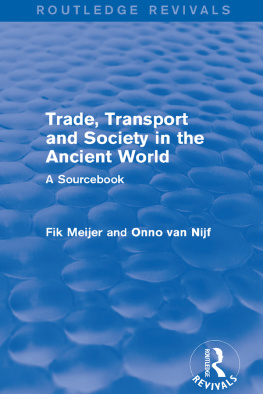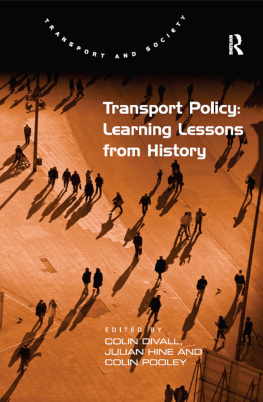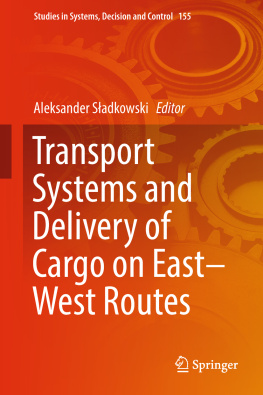European Transport: Problems and Policies
First published 1994 by Ashgate Publishing
Reissued 2018 by Routledge
2 Park Square, Milton Park, Abingdon, Oxon OX14 4RN
711 Third Avenue, New York, NY 10017, USA
Routledge is an imprint of the Taylor & Francis Group, an informa business
Copyright Theo Kiriazidis 1994
All rights reserved. No part of this book may be reprinted or reproduced or utilised in any form or by any electronic, mechanical, or other means, now known or hereafter invented, including photocopying and recording, or in any information storage or retrieval system, without permission in writing from the publishers.
Notice:
Product or corporate names may be trademarks or registered trademarks, and are used only for identification and explanation without intent to infringe.
Publishers Note
The publisher has gone to great lengths to ensure the quality of this reprint but points out that some imperfections in the original copies may be apparent.
Disclaimer
The publisher has made every effort to trace copyright holders and welcomes correspondence from those they have been unable to contact.
A Library of Congress record exists under LC control number: 94008701
ISBN 13: 978-1-138-31369-9 (hbk)
ISBN 13: 978-1-138-33070-2 (pbk)
ISBN 13: 978-0-429-44769-3 (ebk)
Graph 1
Car share in total mobility of train, bus and car 1989
| BR | British Rail |
| CRS | Computerised Reservation Systems |
| CTP | Common Transport Policy of the EC |
| DB | Deutsches Bundesbahn (German Railways) |
| DIR | Danish International Register |
| DRIVE | Dedicated Road Information for Vehicle Safety in Europe |
| ECAC | European Civil Aviation Conference |
| ECMT | European Conference of Ministers of Transport |
| ECU | European Currency Unit |
| EFTA | European Free Trade Association |
| EIB | European Investment Bank |
| ERDF | European Regional Development Fund |
| FS | Ferrovie dello Stato (Italian Railways) |
| GATT | General Agreement on Tariffs and Trade |
| LATA | International Air Transport Association |
| SEA | Single European Act |
| SF | Structural Funds |
| SNCB | Societe Nationale des Chemins de Fer Beiges (Belgian Railways) |
| SNCF | Societe Nationale des Chemins de Fer Francais (French Railways) |
My indebtedness to those who have in one way or another helped in producing this study is extensive. It includes Professor Derek Aldcroft who went through this work and made some useful suggestions for improvement. I am particularly indebted to Ross Catteral for his constant encouragement and emotional support during the writing of this book. Last, but not least, to all those unnamed officials actively involved in the European and national policy making in Brussels, London and Berlin, for their stimulating comments and the documentation they provided, I owe many thanks. Of course, none of them is responsible for arguments and opinions expressed in this study.
Since the mid 1980s transport has become one of the main elements of debate, policy making and legislative implementation in the EC. Transport is a key to the creation of a Common Market without barriers of any kind to the free movement of goods, people, capital and services (including transport as a service). Despite this realisation, however, the European transport policy continues to be a compromise between economic principles and political realities. The book is set against this framework.
Theo Kiriazidis
Cambridge, January 1994
The present book is concerned with the attempts of the EC to integrate the Member States transport sectors since the signing of the Single European Act (SEA) in 1986. Its scope is to identify and evaluate barriers to integration of the European transport sectors and examine critically the new EC transport policy in terms of achieving a dynamic and efficient transport structure capable of accommodating the new internal dimensions of the market and responding to the unfolding changes in the economic and social fields of a more integrated Europe. It explores the obstacles to be overcome in the search of integration in European transport, the conditions necessary to enable progress towards an integrated transport sector to be made and the strengths and weaknesses of the different types of strategies intended to hasten its achievement.
Transport is more than just another sector of economic activity. It accounts for around 7 per cent of GDP, 7 per cent of jobs, 40 per cent of public investment and more than 25 per cent of total energy consumption. The transport equipment industry is one of the principal industrial sectors in the EC, in terms of turnover second only to the food industry. However, any assessment of its importance in terms of the direct contribution to the GNP ignores the role of transport in the overall functioning of the Common Market. The principle of fair and effective competition is inconsistent with any frustration to the access from one Member State to another and from urban areas to economic centres which is serious enough to hinder trade. The problems of the more peripheral regions show that geographic disadvantages may be exacerbated by insufficient transport links resulting in difficult markets contacts for the economies concerned. The transport services industry is essential for the integration of the EC, its economic performance and its social cohesion.
This realisation is not a very recent affair. The subject of transport has been given attention from the early years of European integration. The Common Transport Policy (CTP) was an important part of the Rome Treaty recognising the importance of the sector as a means of promoting integration and accelerating economic growth. However, the specific incorporation of transport in the Treaty of Rome implicitly implied that this sector cannot be subject to its trading rules. National transport policies played an important role in the attainment of regional and social goals. Foreign presence would have an important impact on the effectiveness of such policies and the structure of the domestic transport sector, while changes in the latter were not considered to be desirable. Thus, progress towards an integrated transport system was limited.
In 1985 new initiatives towards a CTP took place as a consequence of a series of reasons such as certain judgements of the Court of Justice and some political pressures from the European parliament and the EC Commission. This trend reinforced by a political decision made at the highest level of the EC Council to carry out the first amendment of the Rome Treaty [the so-called Single European Act (SEA)] introducing new responsibilities for the EC and new procedural rules in the sense of adopting legislation through qualified majority.
The momentum towards completing the internal market coincided with two other developments at the European level. The acceleration of relations between the EC and EFTA to create the so-called European Economic Space and second the developments in the former Eastern Europe present new challenges in the way of elaborating and implementing an EC transport policy.






